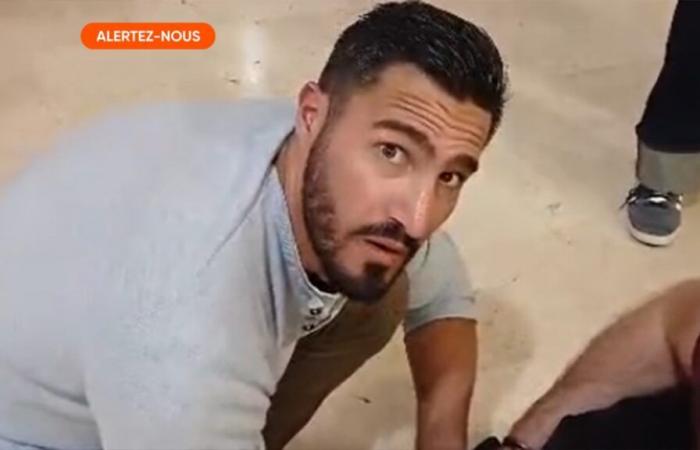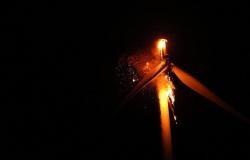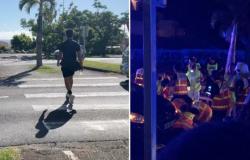
For long minutes, Jean-François says he felt “alone” because no member of the staff of the emergency services arose, and “No defibrillator was at hand”.
It is only after “27 minutes that help arrive on the spot”. The lady is evacuated in a wheelchair to a hospital center. Since then, Jean-François has not heard any news. “This is the last image I have of this lady. The husband thanked me crying. I don’t know what she became. I didn’t sleep for a week. I hope everything went well for her. That’s all I want. A few weeks later, it still touches me.”
Rescue services occupied on “another emergency”
The Spanish airport manager Aena confirms for her part that a discomfort was reported that evening. The airport would have been informed at 7:30 p.m. and the rescue service would have been “immediately” mobilized. But he was then “Occupied on another emergency”. The 112 was also activated in parallel. The emergency services would then have arrived at 7:44 p.m. (where the lady was unwell), followed closely by those of 112, a minute later.
Regarding “the absence of a defibrillator” mentioned by Jean-François in his testimony, Aena claims to have five aircraft distributed in the terminal, including in the boarding zone where the incident took place. “César Manrique-Lanzarote Airport has 5 defibrillators distributed in the terminal (including 2 in the boarding area of Terminal 1, where the passenger has been taken care of). In addition, both health service and rescue service also have portable defibrillators.”
For the Spanish airport manager, the protocols were respected that day. “All airports of the Aena network, including that of Caesar Manrique-Lanzarote, have services guaranteeing first aid and transfer to medical centers, either thanks to the presence of on-site health services, either by the activation of local health entities. César Manrique-Lanzarote airport has a first aid and a activation protocol of 112.”
And conclude: “Aena reaffirms her commitment to passengers, citizens and all employees to guarantee their security, respecting the applicable regulations, including international OACI (International Civil Aviation Organization) in terms of airport health assistance, both for first aid and for emergency transfer procedures to medical centers.”
On the side of Jean-François, the feeling is therefore quite different: “No defibrillator was brought. No doctor intervened. And we had to wait almost half an hour. It is unacceptable.”
In Liège, the firefighter service trained in emergency medical aid
Following this situation experienced in Spain, we interviewed the spokesperson for a Belgian airport to find out what is planned to provide medical aid as quickly as possible.
In Liege Airport, for example, the missions of the fire service are not limited to the fight against flames. “All members of the airport fire service followed the training of a rescuer-Ambulancer in the EPAMU (Provincial School of Urgent Medical School)”indicates the spokesperson Christian Delcourt.
This training allows them to intervene quickly in the event of a medical incident on the airport site. “The fire service agents who still exercise a voluntary firefighter activity in an approved rescue service comply with the legal continuing education requirements: 24 hours of recycling per year, and a renewal of the patent every 5 years, necessary to maintain the validity of the AMU badge (valid 5 years)”, precise Christian Delcourt.
As for agents who are no longer active in an approved service 112, the airport has set up a specific 64 -hour training entitled “Airport ambulance”. “This aims to reclassify employees with airport aid gestures, to prepare them for the management of pathologies specific to this environment, to train them in the preparation of medical equipment (an annual recycling of 16 hours is also planned to maintain these up-to-date skills)”continues the airport spokesperson.
An ambulance is present on site for the intervention, but not for transport to hospitals. “It is important to specify that the Liege Airport fire service does not carry out transport to hospitals, its mission being exclusively focused on the front line intervention on the airport site”, underlines Christian Delcourt. “However, the service has a fully equipped ambulance, responding to the standards of approved ambulances 112, in order to ensure rapid and efficient care pending the arrival of the competent external services.”
For its part, the press service of Brussels Airport evokes the system present within its installations: “There is an emergency doctor and nurse, an ambulance with 2-firefighters, a medical center to which travelers, visitors and staff can contact in the event of medical problems (24 hours a day), a large network of around 40 defibrillators and a large rescue equipment (medical).”







